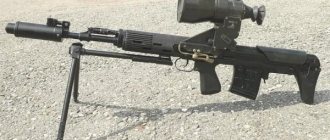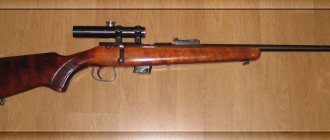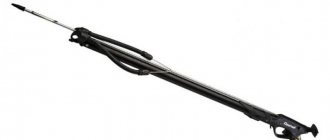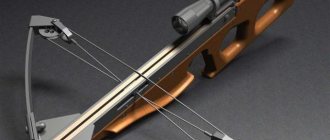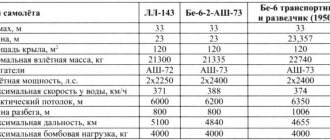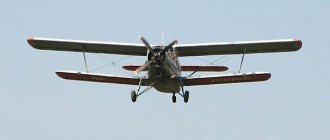What does a fertilized egg look like?
Having learned about their pregnancy, many curious expectant mothers begin to ask the doctor questions about how and at what stage the fertilized egg is visible and what it looks like. We will try to answer them.
The fertilized egg, the diameter of which is very small in the first days of pregnancy, can be seen within two to three weeks after a missed period. The formed structure in most cases is located in the upper part of the uterine cavity, has a dark (gray) tint and a round or oval shape. The embryo at this time is still microscopic in size, so it is not detected by ultrasound.
Ultrasound: what and why
An obstetrician-gynecologist who supervises a woman’s pregnancy process necessarily writes her a referral for ultrasound diagnostics. It must be done three times, at the end of each trimester. Having a pregnant woman undergo this examination and the data obtained during it allow specialists to monitor the condition of the fetus at each stage of its development. The concerns of some expectant mothers regarding the safety of ultrasound are understandable, but many scientific studies have shown that ultrasound waves do not have a negative effect on the embryo, even with repeated exposure. Consequently, these fears are completely vain and groundless.
The health, even the life, of your baby may depend on your decision to undergo sonography.
Development and structure
The growth of the fertilized egg begins from the moment of conception. The fertilized egg begins to move through the fallopian tube, during which cell fragmentation occurs. Making its way to the uterus, the fertilized, crushed egg needs nutrients and oxygen, so after a week a chorion begins to form on top, which subsequently transforms into the placenta.
The surface of the chorion has villi, which help the formation to attach to the uterus. In the future, these villi are contained only at the site of implantation of the formation into the uterine wall. The rest of the structure loses lint and remains smooth. The chorion provides the fetus with all vital functions, one of which is protection against infections.
Twenty days after menstruation, during a hardware examination, you can see the yolk sac, which is designed to provide the fetus with nutrients. The presence of a yolk sac in the fertilized egg does not guarantee a normal pregnancy, but if it is absent, this indicates pathology. Inside the membrane surrounding the embryo there is an amnion - a hollow sac that produces the optimal environment and amniotic fluid for the development of the child.
Often, during an examination, an ultrasound specialist may detect a second fertilized sac. In this case, the woman can be congratulated, as she will have twins. Such a pregnancy develops when two eggs are simultaneously fertilized or two zygotes develop from the same egg.
If a woman is expecting twins, the fertilized egg may form one or two placentas at the time of division.
If the moment of attachment of the egg to the uterus occurs after 8-13 days from the day of fertilization, then 2 fetuses and one placenta are formed for two. This means that both fetuses will develop in the same amniotic sac. If division occurs earlier than this period, then each embryo will develop in its own fertilized egg.
Sizes of fertilized egg by week
A table will help you find out the size of the fertilized egg by week of pregnancy, according to which the obstetrician-gynecologist compares the size of the fetus with the norms for the expected period. The parameters indicated in this table are the most important indicators of the formation of pregnancy, therefore, when the fertilized egg is already visible, the doctor is obliged to determine them.
Ultrasound of the fetal egg at 4 weeks determines the size of only 1 mm. A woman at this time may not even know about the birth of a new life, but a hardware study will already reveal and even show what the fertilized egg looks like at 4 weeks. At this time, the cells of all future organs of the baby are formed.
The size of the fertilized egg increases daily by about 1 mm. When the egg reaches a size of 3 mm, it already has a yolk sac, which provides hematopoietic function and nutrition to the embryo. All elements of the fertilized egg within the fourth week make it possible to confidently establish the presence of pregnancy. It is already possible to examine the embryo during this period. It happens that at a given size the structure of the embryo is not visible. There is no need to panic, since in individual cases the embryo may still be forming at this time.
The question of when an embryo appears in the fertilized egg interests many expectant mothers. Normally, around the fifth week of gestation, the embryo is already visualized on the ultrasound monitor and even a heartbeat is recorded. To clarify the progression of pregnancy, hCG levels are additionally monitored.
A value less than 7 mm indicates the middle of the fifth week. This is one of the most important periods when active formation of blood vessels, heart and nervous system occurs. The size of the embryo is usually 2 mm.
When an ultrasound shows a fertilized egg measuring 10 mm, this indicates that the heart and blood vessels are already fully formed and the embryo has a neural tube with a slight thickening at the end (the future brain).
6 obstetric week visualizes a value of 12 mm. At the 6th obstetric week, the fertilized egg is 12 mm in size, has a spherical shape, the embryo looks like a white stripe about 5-6 mm long. At this point, the heart rate is 110-130 per minute. If any abnormality is detected during the sixth week, a repeat examination a week later is recommended.
During the first two days of the 7th week, the value is determined to be 19-20 mm. During this period, the baby’s brain and genitals are forming; on the ultrasound monitor you can see arms, legs, mouth and nostrils.
Structure dimensions of 21-22 mm indicate the middle of the seventh week. At this time, the development of the brain and face continues. From this period, the child cannot be considered an embryo, since it is already a full-fledged fetus measuring about 10-13 mm.
SVD: what is it?
What does SVD mean on an ultrasound scan is a fairly common question among expectant mothers. In order to assess the size and growth of the fertilized egg, as well as the embryo and fetus, they resort to the use of two indicators, SVD and KTR. SVD is the average internal diameter of the fertilized egg. To determine this indicator, measurements are taken of the length, width and anterior-posterior dimensions of the fetal egg along the internal outline, after which the measurement results are summed up and the sum is divided by three. In a special table, normal indicators are determined for each stage of pregnancy in the first trimester, and ultrasound doctors use the same data to determine the duration of pregnancy. When determining the gestational age using the SVD, the average error is ±6 days. CTP - coccygeal-parietal size - is the first indicator that is measured when visualizing the embryo. To simplify, this is the length of the embryo from the tailbone to the head. It is necessary to pay attention to the fact that CTE is much less subject to individual fluctuations than SVD, therefore determining the gestational age using this indicator gives much more reliable results.
It is much easier to go through the research than to reproach yourself later for carelessness that turned into disaster.
Disorders and pathologies
If the fertilized egg develops incorrectly, a specialist will notice deviations from the norm on an ultrasound.
Deviations from parameters
The growth and size of the fertilized egg and embryo must correspond to the duration of pregnancy. If the fetus is less than 2 mm in size at 5 weeks, a developmental disorder can be stated. Fetal size less than 4 mm at seven weeks so
also indicates a violation. With these parameters, you need to make sure that the set deadline is correct.
A large fertilized egg with a small embryo often indicates a frozen pregnancy. But re-examination is necessary to confirm. A frozen pregnancy can also be indicated by a too small fertilized egg. However, again we need to observe the dynamics of development.
Irregular shape
We can also talk about a violation when the structure surrounding the embryo has a non-standard shape. If the angles of the membrane are uneven, then the specialist may suspect increased uterine tone. In many cases, this condition is harmless, however, if there is pain, dark vaginal discharge, or dilatation of the cervix, then there is a possibility of miscarriage.
To correct the situation, doctors remove the tone of the uterus, after which the egg takes the correct shape. What the fertilized egg looks like during a miscarriage depends on the gestation period. At 1-2 weeks, a miscarriage may look like menstrual bleeding. At later stages, the formation looks like a blood clot. If a miscarriage occurs at 7-9 weeks, the woman may find pieces of fetal tissue.
If the structure is oval and at the same time flat, this may also indicate a frozen pregnancy. However, in the absence of pain and other ailments, it makes sense to continue monitoring the pregnancy. A repeated examination will allow the doctor to draw the correct conclusion.
Wrong location
A low gestational sac does not indicate a serious pathology, but requires more careful monitoring throughout pregnancy. If the formation is very close to the cervix, then cervical pregnancy may occur, which can lead to removal of the uterus.
Empty fertilized egg
With an ectopic pregnancy, you can find an empty ovum when the cavity contains only fluid or a blood clot.
Types of ultrasound. What are SVD and KTR?
To determine the parameters of the ovum, various types of ultrasound are performed:
- Transabdominal - examination occurs through the outer abdominal wall.
- Transvaginal – examination is carried out through the vagina.
With a TA examination, a clear identification of the formation is possible starting from the 5th obstetric week. At this time, the fertilized egg is 5-8 mm in size. Using the second research method, you can determine the size of the fertilized egg on the 3-6th day of missed menstruation, which is 4-5 weeks of gestation.
Read more about the first ultrasound during pregnancy →
The embryo is visualized starting from the 5th week of pregnancy during a TV examination, and during TA - from the 6th week in the form of a linear formation.
To assess the size and growth of the formation and embryo, the following indicators are used:
- SVD is the average internal diameter of the fertilized egg.
- KTP – coccygeal-parietal size of the embryo/fetus.
SVD shows the size of the fertilized egg by week and is measured in millimeters. Thus, the indicator of the size of the fertilized egg constantly varies over the weeks of pregnancy; the CTE indicator is more accurate for determining the reliable gestation period.
In this study, the error may be three days up or down. Basically, the study is carried out up to 12 weeks of gestation.
The size of the fertilized egg helps to quickly determine how far along the pregnancy is and how the fetus develops in the womb.
The first three months of development are the most important, because it is during this time that all the organs and systems of the future baby are actively developing. Accordingly, it is important to undergo a scheduled ultrasound on time, which helps to identify possible deviations and carry out optimal correction of the current situation.
Author: Lyudmila Morozova, especially for Mama66.ru
Unusual Soviet SVD
The first Soviet sniper complex based on the SVD rifle naturally became a testing ground for designers who were tasked with increasing the combat effectiveness of standard weapons chambered for the 7.62 mm rifle cartridge. They tried to make automatic, airborne, smooth-bore and small-caliber weapons from SVD, but not all of the conceived ideas were translated into serial products.
Assault automatic
At the end of the 60s, the Main Rocket and Artillery Directorate (GRAU) of the USSR Ministry of Defense launched a series of research projects to improve standard weapons. In 1968, as part of the research project “Research for new principles and design schemes for the creation of advanced small arms and cartridges,” such research was carried out with the Dragunov SVD sniper rifle.
As part of such research, it was planned to create a model of automatic weapon with an effective firing range of over 300 m. This was done not without regard to the weapons of ideological opponents of that time from NATO countries, where the main infantry weapon of a soldier was assault rifles such as HK G3 or FN FAL. The only Soviet analogue of such a weapon chambered for a rifle cartridge in the Soviet army could only be the SVD rifle. It was from this that they tried to make a machine gun - and a sniper one at that.
Automatic sniper rifle with 20, 15 and 10 round magazines, 1968 gunsforum.com
To implement the stated requirements, Izhevsk designers under the leadership of E.F. Dragunov with the participation of A.N. Voznesensky made a number of changes to the design of the rifle. The automatic SVD received a new trigger mechanism (trigger mechanism), a shortened and thickened barrel, lightweight folding bipod, increased capacity magazines, a modified flash suppressor with a compensator function and a number of other differences. All this made it possible to obtain an automatic weapon with a rate of fire of 720 or 850 rounds per minute (the gas regulator had two firing positions).
It was not possible to achieve satisfactory results of shooting accuracy immediately. During the research process, to achieve them, it was necessary to introduce depreciation of the bipod, change the design of the butt and flash suppressor. At the same time, it turned out that automatic shooting from such a light weapon as the SVD leaves its mark on the requirements for the shooter’s skill level. At the same time, the domestic B-70 significantly surpassed foreign rifles (M14, AR-10 and FN) in terms of automatic fire efficiency.
Automatic sniper rifle B-70, 1970 M. Popenker
Further work within the framework of research led to the creation in 1970 of a product under the designation B-70. However, there were not many differences from the earlier version. The barrel became even shorter, only a 20-place magazine remained in the kit, and the rate of fire dropped to 600-730 rounds per minute. The B-70 was tested at the Shot course in the scope of exercises for the RPK machine gun. Despite the shooters’ results not lower than “good”, further work on the automatic rifle was considered inappropriate. Later, in 1999-2000, based on the design of the bipod of the B-70 rifle, the S-1 quick-release bipod for the SVD rifle was developed in Izhevsk.
Sniper "arrows"
In the 70s and 80s, a whole series of experimental research projects also took place, also aimed at increasing the combat effectiveness of standard weapons. The SVD rifle has become a kind of laboratory for testing a number of non-trivial design solutions. Thus, within the framework of the research project “Flag” E.F. Dragunov designed, on the basis of the SVD, an AF assault rifle chambered for 5.45×39 mm with an RPK74 magazine for 45 rounds and an aiming range of 1000 m. As a result, it was possible to increase the accuracy of fire with a single fire while maintaining the dimensions of a sniper rifle.
5.45 mm AF assault rifle, 70s M. Popenker
In the mid-70s, research into weapons chambered for a feathered sub-caliber bullet with a detachable sabot, which began in the early 60s, reached its peak. The arrow-shaped striking element of such a cartridge had a diameter of 3 to 4.5 mm and an initial speed of over 1000 m/s, and a special muzzle device was required to destroy the pan. The first results of calculations and experiments with such cartridges were carried out using machine guns and machine guns, since it was believed that due to the large dispersion of bullets, it would not be possible to exceed the effectiveness of a sniper cartridge. However, further calculations showed the theoretical probability of increasing the efficiency of firing from a 10-mm SVDG by two to three times at distances over 600 m.
In 1976, new research projects “Finval” opened on the development of a self-loading sniper rifle. The technical specifications provided for a rifle with an optical sight weighing 4 kg, an aiming range of 1500 m and a direct shot range of 600 m. It was also expected that the labor intensity of manufacturing the rifle would be reduced by 10-15% in comparison with the SVD. Leading designer of Izhmash N.I. Lukin, as part of the Finval and Finval-2 research projects, designed and manufactured a number of smooth-bore modifications of the SVD rifle.
As a result of experiments with 10-mm rifles SVDG and SVDG-2, it was possible to achieve effective firing ranges of 1100 m and a direct shot of 660 m. At the same time, the labor intensity of manufacturing such weapons increased almost twenty times. Unstable accuracy of fire, the low stopping effect of the striking element and the danger of flying pallets forced a change in the direction of the search for improving the effectiveness of weapons.
10-mm sniper rifle SVDG (6В1-10) kalashnikov.ru
In the early 80s, as part of the Karabiner research work, work was carried out to create rifles of a new, reduced caliber 6 mm. The first such 6V1-6 rifles were naturally alterations of the SVD with the installation of a new barrel. Rifle M.E. The Dragunov SSV-6 had a press-fit barrel with a length of 720 mm and a closed bolt cup for use with cartridges with intense ballistics. However, the 6-mm complex, having shown low combat effectiveness, did not justify the advances given to it.
Airborne compact
The first attempts to reduce the length of the rifle without reducing the effectiveness of the weapon began to be made by Izhevsk gunsmiths in 1978. The Ministry of Defense required a compact sniper rifle for transportation in an infantry fighting vehicle and the ability to fire through the embrasure of the fighting compartment. The design team including G.N. Nikonova, A.I. Nesterov and A.S. Anisimov proposed for the army a version of the SVD with an AKS74 stock with a rotating cheekpiece, but shooting through triplex glass led to significant errors in aiming the weapon.
Various variants of experimental SVDS EC Ezell rifles
Work on improving the buttstock design continued. Variants of both steel and plastic stocks based on one or two pipes of a cylindrical or conical profile were tested. The development of rifles went in two directions: general arms (army SVDS-A) and special (airborne SVDS-D). The differences between the rifles were only in the different lengths of the weapons, the landing version of which received a barrel shortened to 565 mm. The final choice of the army leadership fell on the landing version, which, by Decree of the Government of the Russian Federation No. 849 of August 26, 1995, was adopted by the RF Armed Forces under the name “7.62 mm Dragunov sniper rifle with a folding stock, SVDS” (index 6B3).
Rifles SVDS-A and SVDS-D EC Ezell
Shortly before the final verdict on the SVDS rifle A.I. Nesterov and A.S. Lomaev tried to make an airborne rifle with combat characteristics close to the SVD, taking into account the experience of the Karabiner R&D. The DSV rifle received a barrel length of 605 mm, but at the same time remained in the dimensions of the SVDS in the stowed position due to the economical layout of the feed and locking mechanisms. However, the matter never progressed beyond the production of a prototype.
Sniper rifle
From 1986 to 1990, the manufacturing process of the SVD rifle underwent certain technological changes. So, the wooden butt was replaced by a plastic one with a rotating cheekpiece. As a result of work under the leadership of A.I. Nesterov increased the strength and ergonomics of the butt. The same fate befell the wooden barrel linings. Thus, the SVD changed its characteristic and recognizable appearance, becoming a completely “black” rifle.
Various versions of SVD rifles depending on the year of manufacture kalashnikov.com
The latest and most radical experiments on the SVD were the redesign of the bullpup-type rifle layout. Since the late 70s, work in this direction was proactively led by the designer of the Tula Central Design Research Bureau of Sporting and Hunting Weapons (TsKIBSOO) L.V. Bondarev. At the same time, it was possible to arouse interest among law enforcement agencies in the TKB-0172 rifle only by adding to the compactness of the weapon the possibility of automatic firing.
The OTs-03A rifle, and then the OTs-03AS variant with the installation of a bipod, attracted the attention of specialists from the USSR Ministry of Internal Affairs. Serial production of the sniper assault rifle began in small batches in Tula in 1991. We obtained OTs-03 by remaking serial SVDs. The weapon was used in many local conflicts in the 90s, receiving mostly positive reviews from users. Ease of transportation and operation at short and medium distances more than compensated for the deterioration in shooting accuracy. At the same time, the greatest claims were made to the results of automatic rifle shooting.
Sniper rifle OTs-03 (SVU) kbptula.com
Bondarev managed to bring the idea of that same B-70 automatic rifle to mass production, albeit in limited quantities.
This was largely influenced by the lack of strict army requirements, which are not essential for use by police forces. At the same time, the dimensions of the Tula sniper rifle, a shortened SVU, were practically able to fit into the dimensions of the SVDS in the transport position. Later, the manufacturer decided to abandon the automatic fire on the OTs-03 in favor of a self-loading version, returning the original long barrel from the SVD to the rifle and maintaining the sufficient compactness of the weapon. Rifle characteristics
| Name | SVD | SVDA | B-70 | SIDS | SVU |
| Weight with optical sight, kg | 4,3 | 4,7 | 5,03 | 4,68 | 5,9 / 6,1 |
| Magazine capacity, cartridges | 10 | 15 / 20 | 20 | 10 | 10 |
| Length in firing position, mm | 1225 | 1165 | 1120 | 1135 | 900 / 980 |
| Length in stowed position, mm | – | – | – | 875 | – |
| Barrel length, mm | 620 | 570 | 530 | 565 | 520 / 620 |
| Sighting line length, mm | 587 | 530 | 490 | 530 | 423 / 500 |
Sources and literature:
- Yu.V. Bushin, V.Yu. Simonenko. Russian small arms ammunition. Volume 2. Automatic, rifle and machine gun cartridges. — M., 2020
- V.N. Dvoryaninov. Small arms live ammunition. Book 4. Klimovsk: D'Solo - 2015
- P. Ptitsyn. Automatic SVD - better than a light machine gun
- Shooting manual. 7.62 mm Dragunov sniper rifle (SVD)
- 7.62 mm Dragunov sniper rifle with folding stock. Form 6B3. FO
- Instruction manual for the 7.62 mm sniper assault rifle OTs-03A

